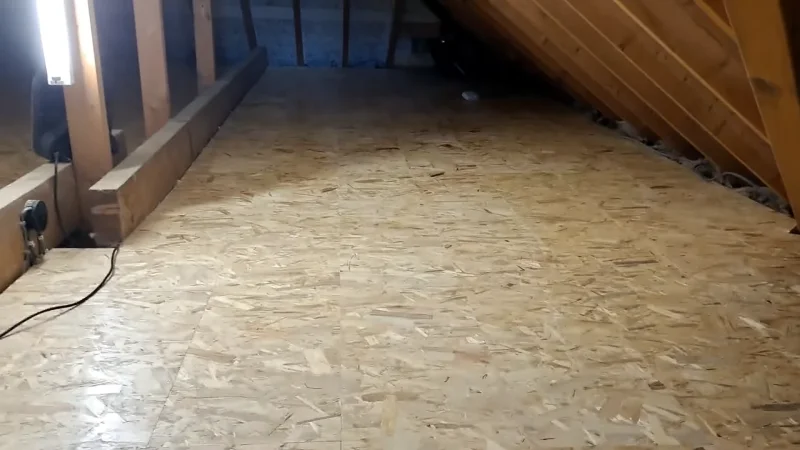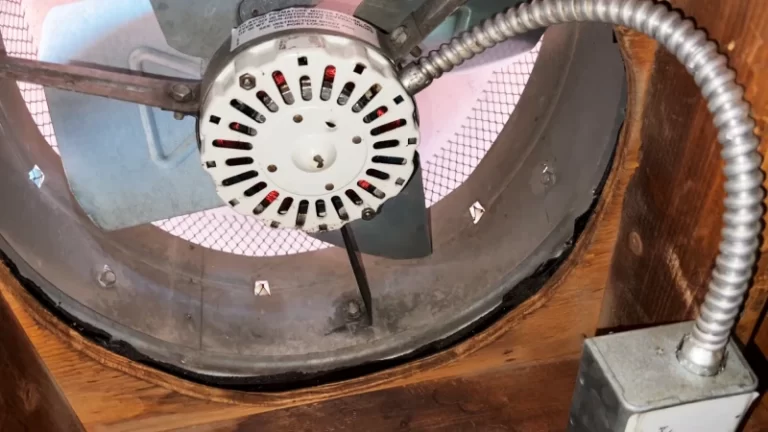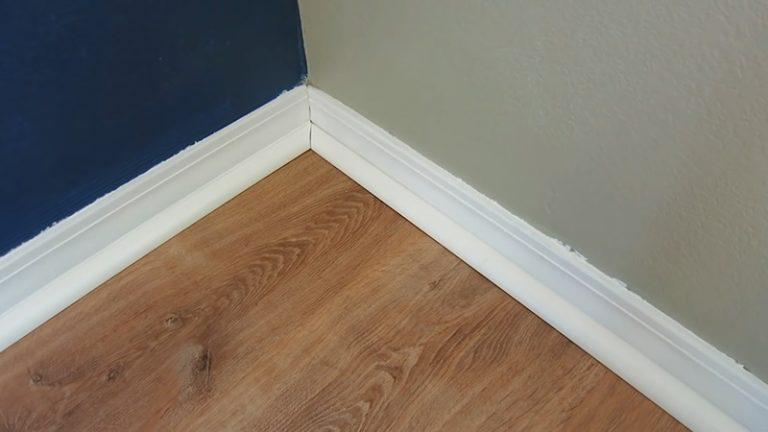Should I Use 7/16 OSB for Attic Flooring?

When it comes to choosing a flooring material for your attic, it’s important to consider both the intended use of the space and the specific characteristics and limitations of the materials you are considering.
One option that may be tempting due to its affordability and ease of installation is 7/16 inch oriented strand board, or OSB. However, as a relatively thin and relatively weak engineered wood panel, OSB is not always the best choice for attic flooring.
In this article, we’ll explore some of the key considerations you should keep in mind when deciding whether 7/16 OSB is suitable for your attic floor.
7/16 Osb for Attic Floor
7/16 OSB, or oriented strand board, is a type of engineered wood panel that is commonly used as a sheathing material in construction. While it is more affordable and easier to work with than plywood, it is generally not recommended for use as a flooring material in an attic.
This is because OSB is not as strong and durable as plywood, and is more prone to moisture damage. It is also not as smooth and stable as plywood, which can make it less comfortable and suitable for walking on.
If you plan to use your attic for storage or as a living space, it is generally a better idea to use 3/4-inch plywood for the flooring. This will provide a stronger, more stable, and more durable surface that is better able to withstand the added weight and activity that comes with using an attic as a living space.
Why Plywood is a Better Choice for Attic Flooring?
Plywood is generally considered a better choice for attic flooring than OSB due to its superior strength and durability. While OSB is made up of small strands of wood that are compressed and bound together with adhesives, plywood is made up of thin layers of wood veneer that are cross-laminated and bonded together with adhesives. This construction method gives plywood a more stable and consistent structure, making it more resistant to warping, cracking, and splitting than OSB.
In addition to being stronger and more durable, plywood is also less prone to moisture damage than OSB. This is because plywood is made up of thin layers of wood that are less prone to swelling and shrinkage due to changes in humidity. This makes it a better choice for attics, which can be prone to moisture and temperature fluctuations.
Finally, plywood has a smooth and stable surface that is more comfortable and suitable for walking on than OSB. This is especially important if you plan to use your attic as a living space or for storing items that will be frequently accessed. Overall, while 7/16 OSB may be a more affordable option, it is generally not as suitable for use as attic flooring as plywood.
Factors to Consider When Choosing Attic Flooring Material
There are several key factors to consider when choosing a flooring material for your attic. These include:
Joist Spacing and Load-bearing Capacity
The spacing and size of your attic joists will determine the type and thickness of flooring material that you can use. If your joists are spaced 16 inches apart or closer, you will need to use a thicker material, such as 3/4-inch plywood, to ensure that the floor is strong and stable enough to support the added weight.
Intended Use of the Attic
If you plan to use your attic for storage, you may be able to get away with using a thinner and less expensive material, such as 7/16 OSB. However, if you plan to use your attic as a living space, you will need to use a stronger and more durable material, such as 3/4-inch plywood, to ensure that the floor can withstand the added weight and activity.
Budget and Cost Considerations
The cost of flooring materials can vary significantly, with plywood generally being more expensive than OSB. While it may be tempting to choose the cheaper option, it’s important to consider the long-term cost of maintenance and repair, as well as the value that a higher-quality flooring material can add to your home.
How to Install 7/16 Osb for Attic Flooring Properly?
Here are a few more tips to consider when choosing a flooring material for your attic:
Insulate the Floor
To make your attic more comfortable and energy-efficient, it’s a good idea to insulate the floor. This can be done with either loose-fill or batt insulation, depending on your preference and the specific needs of your attic. Also consider for return height.
Consider the Finish
If you plan to finish the floor of your attic and use it as a living space, you may want to consider the type of finish you will use. Hardwood, laminate, and tile are all popular choices, but you’ll need to ensure that the subfloor is strong and stable enough to support the added weight and activity.
Check for Pests
Before installing any flooring material in your attic, it’s important to check for pests, such as rats or termites. These pests can cause serious damage to the structure of your home, so it’s important to address any infestations before installing a new floor.
Ventilate the Attic
Proper ventilation is essential for the health and longevity of any attic space. To ensure that your attic stays dry and well-ventilated, be sure to install proper ventilation systems, such as soffit vents and ridge vents.
Follow Building Codes
Be sure to check your local building codes to ensure that your attic flooring meets all necessary requirements. This will help to ensure that your attic is safe and up to code, and will also help to protect the value of your home.
Tips to Consider When Choosing a Flooring Material for Your Attic
Here are a few more tips to consider when choosing a flooring material for your attic:
Consider the Slope of the Roof
If your attic has a steep slope, you may need to use a flooring material that is more flexible and able to conform to the contours of the roof. In these cases, a thinner and more pliable material, such as plywood or a floating floor system, may be a better choice.
Consider the Humidity Level
If your attic is prone to high humidity levels, you’ll want to choose a flooring material that is resistant to moisture. Bamboo and cork are both good options in these cases, as they are naturally resistant to moisture and can withstand high humidity levels.
Consider the Weight of the Flooring Material
If you have limited access to your attic and will need to carry the flooring material up a narrow and steep staircase, you may want to choose a lighter material to make the installation process easier.
Consider the Cost of Installation
In addition to the cost of the flooring material itself, you’ll also need to consider the cost of installation. If you plan to install the flooring yourself, you’ll need to factor in the cost of tools and supplies, as well as your own labor. If you plan to hire a professional, be sure to get multiple quotes and compare prices before making a decision.
Consider the Future Use of the Attic
It’s important to consider the future use of your attic when choosing a flooring material. If you plan to use the attic as a living space or for storage in the future, you’ll want to choose a material that is strong and durable enough to withstand the added weight and activity. If you’re not sure how you’ll use the space in the future, it’s a good idea to choose a more versatile and flexible material that can be used for a variety of purposes.
Should I Use 7/16 OSB for Attic Flooring?
7/16 OSB (oriented strand board) is not recommended for use as an attic floor. It is primarily used as a structural panel for walls and roofs, and is not designed to hold the same weight and load as a floor. When it comes to attic flooring, it is important to use a material that is strong and durable enough to support the weight of furniture, boxes, and other items that may be stored in the attic.
The recommended thickness for attic flooring is at least 3/4 inch, and it is generally best to use plywood rather than OSB. Plywood has a higher compressional strength than OSB, making it more suitable for flooring applications. Additionally, plywood is more resistant to moisture, which is important in an attic where there may be fluctuations in humidity.
Overall, it is not a good idea to use 7/16 OSB for an attic floor. It is better to invest in a higher-quality material such as 3/4 inch plywood to ensure the stability and durability of the attic floor.
Conclusion
In conclusion, 7/16 OSB is not typically recommended for use as attic flooring due to its relatively weak and moisture-prone nature. While it may be a more affordable option, it is generally not as strong or durable as plywood, and is not as comfortable or suitable for walking on.
If you plan to use your attic as a living space or for storing items that will be frequently accessed, it is generally a better idea to use 3/4-inch plywood for the flooring. This will provide a stronger, more stable, and more durable surface that is better able to withstand the added weight and activity that comes with using an attic as a living space.
Ultimately, the choice of flooring material for your attic will depend on your specific needs and circumstances, so it’s important to carefully consider your options and choose a material that is suitable for your specific situation.


![Flashing Where Siding Meets Concrete [Sealing, Fixing, Prevention]](https://fixitinthehome.com/wp-content/uploads/2023/02/Flashing-Where-Siding-Meets-Concrete-768x432.webp)

![Premixed Thinset Vs Mix It Yourself [Which is Better?]](https://fixitinthehome.com/wp-content/uploads/2023/01/pre-mix-thinset-vs-mix-it-yourself-768x432.webp)
